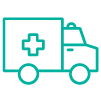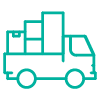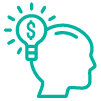A personal line of credit is a type of financing that allows you to withdraw funds as needed, up to a predetermined limit. This can typically range from $1,000 to $100,000, but keep in mind that personal lines of credit are temporary. Since you won’t need collateral, it’s a type of unsecured loan that consumers can sometimes only qualify for if they’re already a customer of the issuing financial institution.
There are a few important factors you should keep in mind:
While personal loans offer consumers a lump sum of money with fixed interest rates and monthly payments, personal lines of credit work more like a credit card.
When you’re offered a personal line of credit, you’re provided a limit to how much you can borrow; you may withdraw as much or as little as you need. Interest is only charged on the amount you take out, and rates are typically variable — this can make it more difficult to predict your monthly payment and total financing cost.
Because a personal line of credit is an open-end credit transaction, you can withdraw from your account multiple times during the draw period and only repay the funds you borrowed, plus interest.
Open-end vs. closed-end credit transaction: What’s the difference?
Interest rates are variable on personal lines of credit, which means they’re subject to change at any time. This can make it more difficult to predict your monthly payment and total financing cost. However, the bank or issuer must give you advance notice that your rate is changing.
With lines of credit, you only pay interest on the money you borrow, which makes it a good option if you don’t know the final cost of a financing venture. Interest accrues as soon as you withdraw funding and will be added to your monthly payment.
In contrast, fixed-rate personal loans come with a set interest rate and repayment schedule. You pay interest on the total lump sum borrowed, not just on the money you use.
Like most types of credit, when you open up a personal line of credit, you may be required to pay several types of fees. Here are a few types of fees you may be charged:
When shopping around for a personal line of credit, aside from interest rates, be sure to compare the fees lenders charge.







| Pros | Cons |
|---|---|
Can withdraw funds on an as-needed basis Flexible in how you can use your funds Consistent access to funds when you need them Required to pay interest on only the funds you take out | May have to pay a fee each time you withdraw money May be charged application and maintenance fees Variable interest rates can make it challenging to budget Consistently withdrawing large amounts may impact your credit score |
An unsecured line of credit doesn’t require any collateral and instead focuses entirely on your creditworthiness. This may make it challenging for consumers with poor credit to qualify or receive lower interest rates.
With a secured line of credit, you’ll need to offer your lender a form of valuable collateral. This puts less risk on the lender, especially if you have less-than-stellar credit — plus, you may be able to obtain lower interest rates as well. For instance, when you apply for a HELOC, you’re borrowing against the equity of your home and using your house as collateral.
A business line of credit works just like a personal line of credit, though these types of credit are specifically for business owners. Their credit limits may also be higher: Business lines of credit are typically capped between $100,000 and $250,000.
When you take out a personal line of credit, there will be a period during which you’re allowed to take money out — known as a draw period — and a period when you’ll need to repay the money — called the repayment period. During the repayment period, you’ll only be responsible for paying back what you borrowed.
Lenders may approach repayment periods differently — here are some of the most common approaches:
The best financing option will depend on your financial situation and unique needs. While a personal line of credit isn’t a good option for everyday purchases due to withdrawal fees, it could be an efficient way to finance a project when you don’t know the total cost.
No, a personal line of credit is a revolving account that you can use like a credit card, in that you only withdraw the funding that you need. But credit cards and personal lines of credit have different methods for withdrawing funds. Plus, credit cards have an interest grace period, whereas you’ll start accruing interest on a personal line of credit as soon as you withdraw funds.
Banks or lenders may require a hard-credit inquiry when you formally apply for a personal line of credit. This can cause a temporary drop in your credit score, but it’s not a derogatory mark. If you utilize too much of your available credit, your credit utilization percentage will go up, which can have a negative effect on your score. If you miss payments, your credit score will likely take a hit.
On the other hand, making on-time and in-full payments on your line of credit can help you build a healthy payment history, which can increase your credit score.
Personal lines of credit are typically reserved for those with good and excellent credit. You’ll likely need a score of around 670 or higher to qualify.
Personal lines of credit allow you to borrow and pay interest on only the money you need. You may see lower APRs than what’s offered by a credit card issuer. This financing option works well for long-term projects without a set final cost. Plus, there’s no collateral, so you don’t risk losing an asset like your car or home.
Personal lines of credit may not be a good option for borrowers with bad credit or consumers who struggle with overspending. Since this financing option has variable interest rates, it’s hard to nail down how much you’ll pay in interest or what you’ll owe each month. If you’d prefer fixed payments and a clear timeline for repayment, you may prefer a personal loan instead.
Personal lines of credit have variable payments that depend on how much you borrow and what the interest rate is. Payments typically begin as soon as you borrow, and you’ll have to make a minimum monthly payment, much like a credit card. Payment schedules vary between institutions.
It may be difficult to obtain a personal line of credit that doesn’t require collateral if you don’t already have a good relationship with a financial institution (a bank, credit union or online lender). Unsecured lines of credit also require that you have a good credit score.
Since personal lines of credit are revolving forms of credit that allow you to borrow against a specified sum, there are several forms of credit that could be considered personal lines of credit including HELOCs.